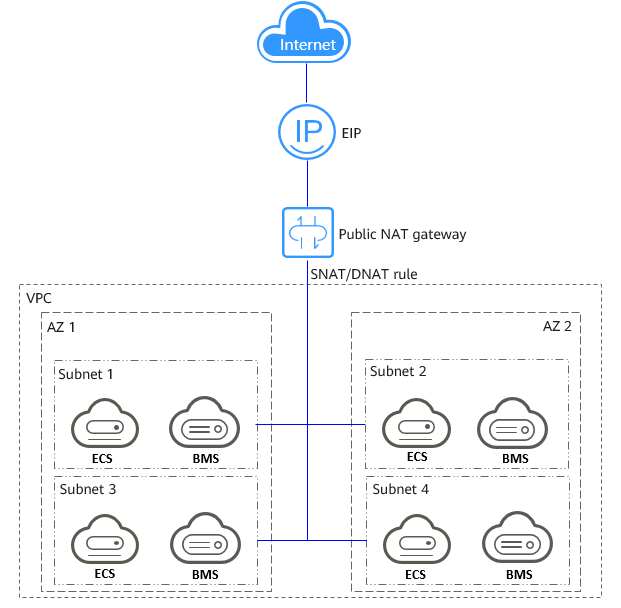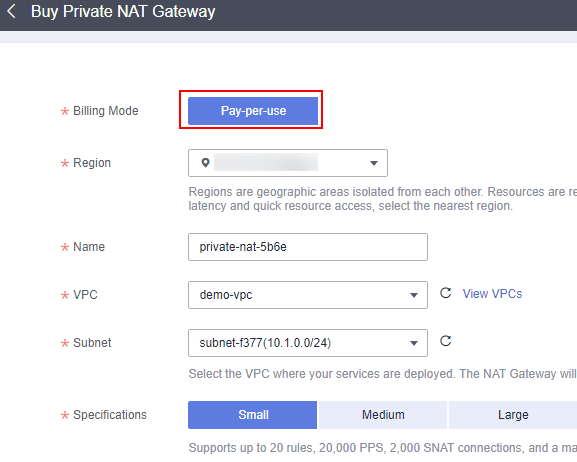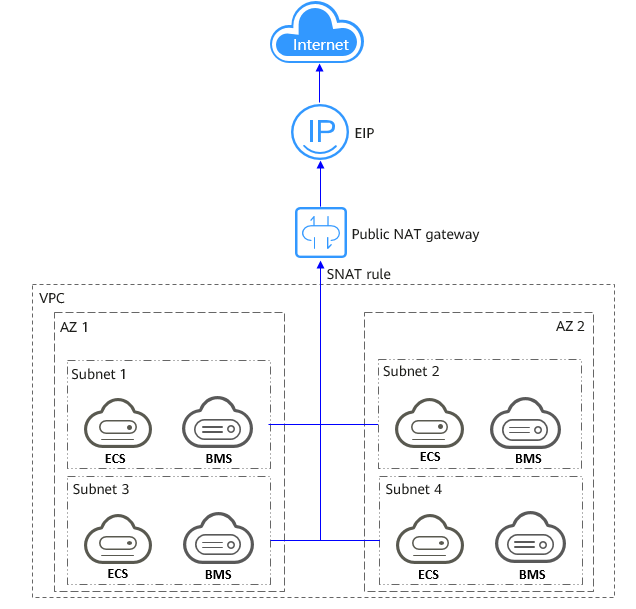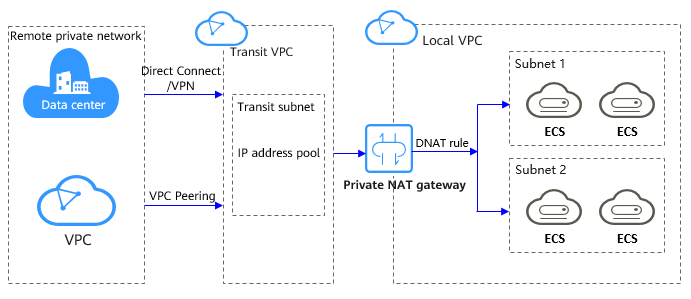Function Overview
-
Public NAT Gateway
-
Public NAT gateways provide NAT for servers in a VPC or on-premises servers that connect to the cloud through Direct Connect or Virtual Private Network (VPN), allowing multiple servers to share EIPs for Internet connectivity.


Public NAT Gateway: All regions
-
-
Private NAT Gateway
-
Private NAT gateways provide private address translation for servers in a VPC, enabling the servers to communicate with remote private networks.


Private NAT Gateway: AP-Bangkok, AP-Singapore, China-Hong Kong, CN North-Beijing4, CN East-Shanghai1, CN East-Shanghai2, CN South-Guangzhou, Africa-Johannesburg, and Southwest-Guiyang1
-
-
Public NAT Gateway-Pay-per-use Billing Mode
-
Public NAT gateways are billed based on the public NAT gateway type and service duration. There are four types of public NAT gateways: small, medium, large, and ultra-large. Public NAT gateways can be billed on a pay-per-use (day) basis.


Public NAT Gateway: All regions
-
-
Private NAT Gateway-Pay-per-use Billing Mode
-
Private NAT gateways started to charge in some regions from April 21, 2022. Private NAT gateways are billed based on the gateway type and service duration. There are four types of private NAT gateways: small, medium, large, and ultra-large. Private NAT gateways can be billed on a pay-per-use (hour) basis.


Private NAT Gateway: CN North-Beijing4, CN East-Shanghai1, and CN South-Guangzhou
-
-
SNAT Rule
-
There are public NAT gateways and private NAT gateways.
- Public NAT gateways support source NAT (SNAT) and destination NAT (DNAT).
SNAT translates private IP addresses into EIPs, allowing servers within an AZ or across multiple AZs in a VPC to share EIPs to access the Internet.
DNAT enables multiple servers within an AZ or across multiple AZs in a VPC to share EIPs to provide services accessible from the Internet. With an EIP, a NAT gateway forwards the Internet requests from only a specific port and over a specific protocol to a specific port of a server, or it can forward all requests to the server regardless of which port they originated on.
- Private NAT gateways provide private address translation for servers in a VPC, enabling the servers to communicate with remote private networks (other VPCs or on-premises servers).
SNAT enables multiple servers within an AZ or across AZs in a VPC to share a transit IP address to access servers in remote private networks.
DNAT enables servers within an AZ or across multiple AZs in a VPC to share the same transit IP address to provide services accessible from servers in remote private networks.



Public NAT Gateway: All regions
Private NAT Gateway: AP-Bangkok, AP-Singapore, China-Hong Kong, CN North-Beijing4, CN East-Shanghai1, CN East-Shanghai2, CN South-Guangzhou, Africa-Johannesburg, and Southwest-Guiyang1
-
-
DNAT Rule
-
There are public NAT gateways and private NAT gateways.
- Public NAT gateways support source NAT (SNAT) and destination NAT (DNAT).
SNAT translates private IP addresses into EIPs, allowing servers within an AZ or across multiple AZs in a VPC to share EIPs to access the Internet.
DNAT enables multiple servers within an AZ or across multiple AZs in a VPC to share EIPs to provide services accessible from the Internet. With an EIP, a NAT gateway forwards the Internet requests from only a specific port and over a specific protocol to a specific port of a server, or it can forward all requests to the server regardless of which port they originated on.
- Private NAT gateways provide private address translation for servers in a VPC, enabling the servers to communicate with remote private networks (other VPCs or on-premises servers).
SNAT enables multiple servers within an AZ or across AZs in a VPC to share a transit IP address to access servers in remote private networks.
DNAT enables servers within an AZ or across multiple AZs in a VPC to share the same transit IP address to provide services accessible from servers in remote private networks.



Public NAT Gateway: All regions
Private NAT Gateway: AP-Bangkok, AP-Singapore, China-Hong Kong, CN North-Beijing4, CN East-Shanghai1, CN East-Shanghai2, CN South-Guangzhou, Africa-Johannesburg, and Southwest-Guiyang1
-
-
Public NAT Gateway-SNAT and DNAT Rules-EIP Sharing
-
When adding SNAT and DNAT rules on a public NAT gateway, you can use the same EIP.



Public NAT Gateway: All regions
-
-
Enterprise Project
-
NAT Gateway resources can be managed by enterprise project. You can add NAT Gateway resources to or remove NAT Gateway resources from an enterprise project. You must manage NAT Gateway resources based on the permissions granted with the user group you belong to.



Public NAT Gateway: All regions
Private NAT Gateway: CN North-Beijing4, CN East-Shanghai1, CN South-Guangzhou, CN Southwest-Guiyang1, China-Hong Kong, AP-Bangkok, AP-Singapore, and Africa-Johannesburg
-
Feedback
Was this page helpful?
Provide feedbackThank you very much for your feedback. We will continue working to improve the documentation.See the reply and handling status in My Cloud VOC.
For any further questions, feel free to contact us through the chatbot.
Chatbot






